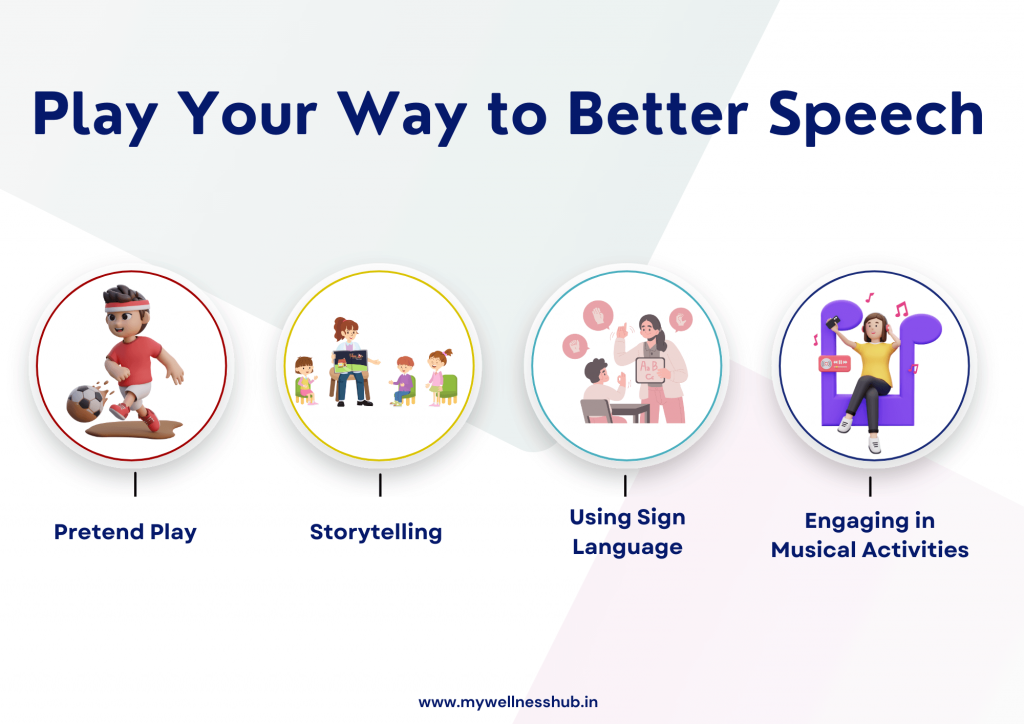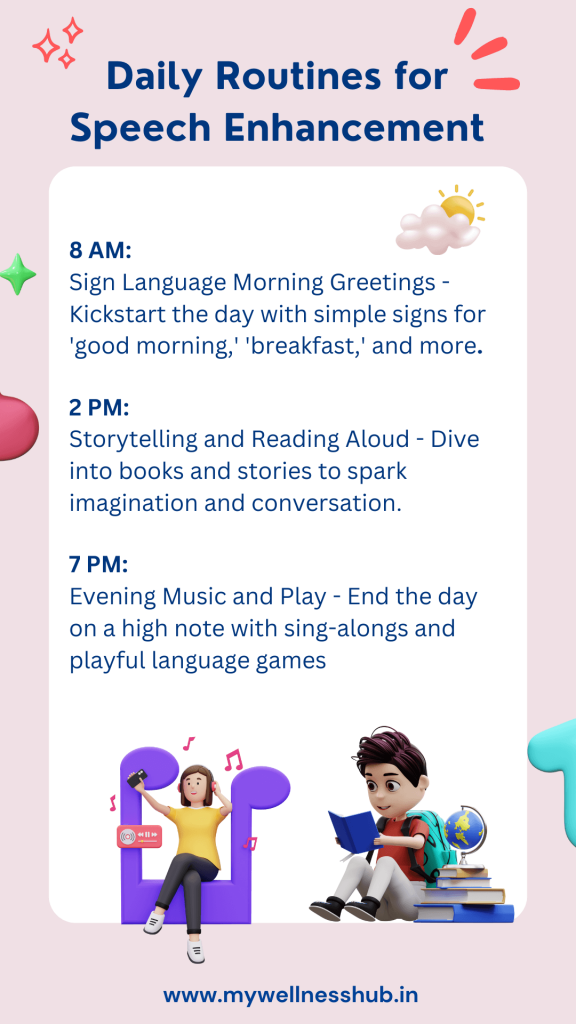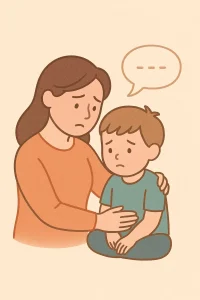Unlock Expressive Language in ASD Kids: 8 Proven Strategies
By Rajini D
Last Updated: April 10, 2024
Have you ever paused to think about the power of words? For many of us, expressing our needs, wants, and feelings comes naturally. But for children with Autism Spectrum Disorder (ASD), it can be a world filled with challenges. Expressive language skills—the tools we use to convey our thoughts and emotions—are often areas where ASD children need support. Improving these skills is more than just learning to speak; it’s about unlocking a new realm of interaction, helping these young minds to share their inner worlds with us.
Why is this important?
Imagine not being able to tell someone you’re hungry, tired, or just want a hug. For children with ASD, this struggle is real. Enhancing their ability to express themselves verbally can drastically change their daily experiences, enriching their social interactions and emotional connections. It’s not just about forming words but about building bridges with the people around them.
Understanding Expressive Language in ASD
The Essence of Expressive Language
When we talk about expressive language, we’re referring to the ability to use words, gestures, or other forms of communication to share our thoughts, desires, and emotions. For children with Autism Spectrum Disorder (ASD), mastering expressive language is often a challenging journey. This crucial aspect of communication allows us to not just convey basic needs but also to participate in rich, meaningful conversations with those around us.
Challenges in Expressive Language for ASD Children
For many children with ASD, the path to developing expressive language skills is filled with hurdles. They might find it hard to put their thoughts into words, struggle to initiate or maintain conversations or have difficulty understanding the give-and-take nature of social communication. Some may repeat phrases they’ve heard (echolalia) without necessarily understanding the meaning of what they say. These challenges can lead to frustration, not just for the children themselves but also for their families and caregivers.
Unlocking Potential with Personalized Strategies
However, it’s important to remember that with the right strategies and support, significant progress can be made. Each child with ASD is unique, and so, too, is their ability to develop expressive language skills. By embracing a personalized approach that builds on their strengths and interests, we can unlock their potential for growth in this area.
Also read: Autism and Stuttering: Strategies for Effective Communication
8 Actionable Tips for Enhancing Expressive Language
1. Embrace the Power of Play
Play is not just a way for children to pass the time; it’s a fundamental part of learning and development, especially when it comes to expressive language in ASD. Through pretend play, using toys, and engaging in role-playing scenarios, children with Autism Spectrum Disorder can experiment with words and phrases in a low-pressure environment. This kind of play stimulates their imagination and encourages them to use language in new and creative ways.

To make the most of playtime, focus on using open-ended questions that require more than a yes or no answer. For instance, if your child is playing with a toy kitchen, you might ask, “What are you cooking for dinner?” or “Who are we inviting to our tea party?” These questions invite your child to formulate responses that go beyond single-word answers, encouraging them to construct sentences and express complex ideas.
2. Incorporate Books and Storytelling
Reading together is a timeless activity with countless benefits, particularly for children with ASD working on their expressive language skills. Books open up new worlds of imagination and provide a fantastic platform for language development. When choosing books, consider those without words or with minimal text. Wordless books encourage children to tell the story in their own words, pushing them to use expressive language to describe what’s happening in the pictures.
As you read together, pause frequently to ask open-ended questions about the story. Questions like “What do you think happens next?” or “How do you think she feels?” help children with ASD practice predicting outcomes and expressing emotions—key components of effective communication.
3. Simplify Communication with Sign Language
Introducing simple sign language is a transformative approach to enhancing verbal skills in children with autism. This method supports verbal communication, especially for early learners who may find it challenging to express themselves using words. Sign language offers a visual and kinesthetic communication pathway, often more accessible for children on the spectrum.
The benefits of using sign language are manifold. It can reduce frustration by providing a means to communicate basic needs and desires, even before spoken language develops fully. Sign language also encourages the development of verbal skills, as children are likely to vocalize while signing. It serves as a bridge to speech, reinforcing the connection between gestures and words.
Starting with essential signs for “more,” “done,” “eat,” and “play” can make a significant difference in daily communication. These signs are intuitive and can be easily incorporated into daily routines, making them a practical tool for both children and their caregivers. Remember, consistency is key. Use signs regularly and pair them with verbal language to enhance understanding and expression.
Read more: Alternative Solutions for Nonverbal Children
4. Create Opportunities for Language Use
Creating opportunities for language use is vital in learning how to improve expressive language in children with autism. By setting up situations that require your child to use words to express their needs, desires, or feelings, you’re not only encouraging them to speak but also to think about how to use language effectively.
One simple strategy is to place favorite toys or items slightly out of reach. This gentle barrier encourages children to ask for help or use specific words to express what they want. For example, if a child wants a toy that’s on a shelf, they might need to say “toy” or “help” to get it. This method teaches them the power of using words to meet their needs.
Another effective approach is to give choices. Instead of guessing what your child might want, offer them two options and encourage them to verbalize their preference. This can be anything from choosing between snacks (“Would you like an apple or banana?“) to selecting which game to play. Not only does this encourage language use, but it also fosters decision-making skills.
5. Limit Screen Time, Promote Real-Time Interaction
In today’s digital age, screens often captivate children’s attention, from tablets to television. While these devices can be educational, excessive screen time might impede the development of essential expressive language skills. For children with Autism Spectrum Disorder (ASD), engaging in speech therapy through ASD-targeted activities can be significantly more beneficial when accompanied by interactive play that demands verbal communication.
Reducing screen time doesn’t mean eliminating fun. On the contrary, it opens the door to a myriad of activities that promote language development and real-time interaction. Simple games like “I Spy,” storytelling, and playing with toys that encourage role-playing can significantly enhance verbal skills. These activities require direct communication, offering endless opportunities for children to practice and improve their language skills.
6. Engage in Musical Activities
Music holds a universal appeal and has a unique way of enhancing learning, making it a perfect tool for speech improvement in ASD. Singing songs, especially those with repetitive phrases and simple melodies, can encourage verbal imitation in children with ASD. Music activities don’t just entertain; they educate.
Incorporating music into your child’s routine can be as simple as singing nursery rhymes together, making up songs about daily activities, or using musical instruments to create a fun, interactive learning environment. The rhythm and melody of songs aid memory and can help children remember words and phrases, improving their ability to communicate.
7. Utilize Visual Supports
Visual supports are a cornerstone technique to aid language development in children with ASD. These tools can transform abstract concepts into something tangible, making communication more accessible and less intimidating. Visual cues, such as picture boards, flashcards, and charts, provide a concrete way for children to express their needs, feelings, and thoughts without solely relying on verbal communication.
Integrating visual supports into daily routines can be both simple and effective. For example, a visual schedule can help a child understand and anticipate daily activities, reducing anxiety and opening up opportunities for verbal interaction about the day’s events. Similarly, picture boards can facilitate choices, allowing children to point to what they want to eat, play, or do, thereby supporting the development of decision-making and preference expression skills.
Know more: Visual Communication and Autism: The Power of Visual Schedules
8. Celebrate and Reinforce Efforts
Acknowledgment and positive reinforcement can significantly impact the motivation and confidence of children with ASD in their journey toward developing expressive language. Every attempt at communication, whether a word, gesture, or even an attempt to use visual support, is a step forward and deserves recognition.
Celebrating these efforts reinforces the idea that communication is valuable and effective. Simple phrases like “I love how you used your words to ask for help!” or “Great job telling me what you need!” can boost a child’s confidence immensely. Positive reinforcement encourages more frequent attempts at communication and helps children understand the power of their voice.
Comparing Communication Strategies
| Strategy | Description | Pros | Cons |
|---|---|---|---|
| Pretend Play | Uses imaginative scenarios to foster communication. | – Boosts creativity and verbal skills. – Encourages social interaction. | – May require guidance to keep focused. – Not all children may engage equally. |
| Books and Storytelling | Reading and telling stories to develop language and comprehension. | – Enhances vocabulary. – Improves listening and understanding. | – Some children may find long stories overwhelming. – Requires regular practice. |
| Sign Language | Using hand gestures to communicate words and needs. | – Reduces frustration by providing an alternative to verbal speech. – Can be used with non-verbal children. | – Learning curve for parents and children. – May not be understood by all communicators. |
| Real-Time Interaction vs. Screen Time | Prioritizing face-to-face activities over digital engagement. | – Promotes social skills and verbal communication. – Encourages more active participation. | – Limiting screen time can be challenging. – Requires more direct supervision and involvement. |
| Musical Activities | Incorporating music and songs to encourage language development. | – Makes learning fun and engaging. – Enhances memory of new words. | – Not all children may be interested in music. – Some activities may require resources (instruments, etc.). |
| Visual Supports | Using pictures and symbols to aid communication. | – Helps with understanding and using language. – Can be customized to individual needs. | – It requires time to prepare and update for children who are not visually oriented. |

Conclusion
On our journey to help children with ASD speak better, we’ve talked about many ways to help. From playing together and reading stories to using hand signs and pictures, each idea helps kids share their thoughts and feelings. We’ve learned how important it is to talk, sing, and play instead of watching screens, and how saying “well done” for even small tries can make a big difference. These tips aren’t just about talking; they’re about connecting with each other.
At Wellness Hub, we want to help every family find what works best for their child. We’re here with advice and support to make talking easier for kids with ASD. Remember, each small step is a big win. Let’s work together to help your child express themselves. With patience and love, we can make sure every child’s voice is heard.
Frequently Asked Questions:
1. How can I help my child with ASD improve their expressive language skills?
Start by engaging in interactive play, using books and storytelling, simplifying communication with sign language, and creating opportunities for your child to use language during daily routines. Limiting screen time in favor of real-life interactions, engaging in musical activities, utilizing visual supports, and celebrating every attempt at communication can also be very effective. Experiment with these strategies to find what works best for your child.
2. Why is play important for developing expressive language in children with ASD?
Play is crucial because it provides a natural and enjoyable way for children to learn communication skills. Through play, children with ASD can practice using words and sentences in a low-pressure environment, learn to take turns in conversation, and express their thoughts and feelings more freely.
3. How does reducing screen time help children with ASD improve their expressive language?
Reducing screen time encourages children to engage in activities that require more direct communication and interaction with others. This helps them practice and develop their verbal skills, as well as understand and participate in real-world social cues and conversations.
4. Can music really help improve speech in children with ASD?
Yes, music and singing can significantly help improve speech and language skills in children with ASD. Music stimulates different parts of the brain involved in language development and can make learning new words and phrases more enjoyable and memorable for children.
5. What are visual supports, and how do they aid in language development for children with ASD?
Visual supports include tools like picture boards, flashcards, and visual schedules that provide a visual representation of language concepts. These supports help children with ASD understand and use language more effectively by associating words with images, which can be easier for them to process.
6. How important is it to acknowledge and celebrate every communication attempt by a child with ASD?
It’s very important. Acknowledging and celebrating every attempt, no matter how small, boosts a child’s confidence and motivation to communicate. Positive reinforcement shows children that their efforts to use language are valued and encourages them to keep trying.
7. What strategies can I use at home to improve my child’s expressive language if they have ASD?
At home, you can use several strategies to enhance your child’s expressive language skills. These include engaging in meaningful play, reading together and discussing stories, teaching simple sign language for basic needs and feelings, and integrating music and songs into your daily routine. Additionally, using visual supports like picture boards can help your child understand and use new words. Always remember to praise any attempt at communication to encourage more attempts and build confidence.
8. How does sign language benefit children with ASD in developing expressive language?
Sign language provides a visual and physical way to communicate, which can be easier for some children with ASD to understand and use compared to spoken words. It can decrease frustration by giving them a way to express their needs and feelings. Moreover, it can serve as a stepping stone to developing verbal language by reinforcing the link between gestures and words.
9. Are there specific toys or games that can help improve expressive language in children with ASD?
Yes, toys and games that encourage role-play, storytelling, and imaginative play can be particularly beneficial. For example, toy sets that involve characters, animals, or everyday scenarios can prompt children to narrate actions or stories. Additionally, interactive games that require taking turns and describing actions or objects can also support language development.
10. How can I make reading more interactive and beneficial for my child with ASD’s expressive language development?
To make reading more interactive, choose books with vibrant pictures and ask open-ended questions about the story or what might happen next. You can also encourage your child to predict outcomes or express what characters might be feeling. Wordless books are especially useful because they allow children to use their own words to tell the story, fostering creativity and narrative skills.
About the Author:
Rajini Darugupally
M.Sc., Speech-Language Pathologist (9+ years of experience)
Rajini is a passionate and dedicated Speech-Language Pathologist with over 9+ years of experience, specializing in both developmental speech and language disorders in children and rehabilitation in adults. Driven by a desire to empower each individual to find their voice, Rajini brings a wealth of experience and a warm, genuine approach to therapy.
Currently, at Wellness Hub, she thrives in a team environment that values innovation, compassion, and achieving results for their clients.
Connect with Rajini to learn more about how she can help you or your loved one find their voice.
Book your Free Consultation Today
Parent/Caregiver Info:
Client’s Details:
* Error Message








